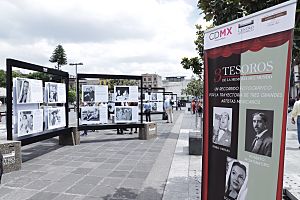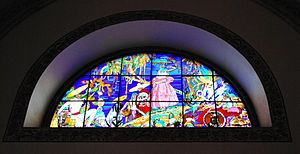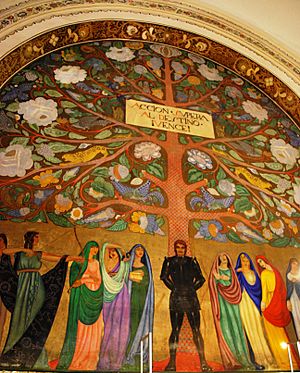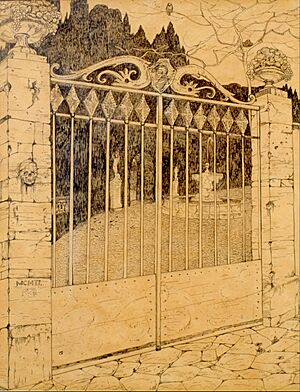Roberto Montenegro facts for kids
Quick facts for kids
Roberto Montenegro
|
|
|---|---|

An exhibition in Mexico City of Montenegro, Dolores del Río and Pedro Vargas, which includes a photograph of him (far right)
|
|
| Born |
Roberto Montenegro Nervo
February 19, 1885 |
| Died | October 13, 1968 (aged 81) |
| Nationality | Mexican |
| Known for | Painting |
Roberto Montenegro Nervo (born February 19, 1885, in Guadalajara, Mexico – died October 13, 1968, in Mexico City) was a famous Mexican artist. He was a painter, a muralist (someone who paints large wall art), and an illustrator. He was one of the first artists to join the Mexican muralism movement after the Mexican Revolution.
His most important murals are at the old San Pedro and San Pablo monastery. However, his art was not as dramatic as other muralists like Diego Rivera. Because of this, he became less known in the mural movement. Most of his career focused on drawing for books, painting portraits, and helping to promote Mexican handcrafts and folk art.
Contents
Life of Roberto Montenegro
Roberto Montenegro Nervo was born on February 19, 1885, in Guadalajara, Mexico. His parents were Colonel Ignacio L. Montenegro and María Nervo. María was the aunt of the famous poet Amado Nervo. Roberto had four sisters and one brother.
His family was well-off during the time of President Porfirio Díaz. When the Mexican Revolution started in 1910, his family moved to the United States. They came back to Mexico in the mid-1920s.
We don't know much about Roberto's childhood. He once mentioned enjoying buying pastries and admiring the colors and shapes of everyday things. He started drawing at a boys' school. This led him to study with Félix Bernardelli, who taught painting and music in Guadalajara. Bernardelli introduced Roberto to the Art Nouveau style.
Studying Art in Mexico and Europe
In 1903, Roberto moved to Mexico City. His father wanted him to study architecture. Through his cousin Amado Nervo, he met many important people in Mexico City. From 1904 to 1906, he studied drawing and history at the Academy of San Carlos.
His teachers included famous artists like Leandro Izaguirre. His classmates were also future famous artists such as Diego Rivera and Frida Kahlo. He learned about Japanese art, which influenced some of his drawings.
In 1906, Roberto and Diego Rivera both wanted to study in Europe. Roberto won a coin toss and went to Europe first. Diego Rivera followed a few months later. Roberto first studied in Madrid, Spain, at the Academy of San Fernando. He loved the Prado Museum and studied the works of great painters like El Greco and Goya.
From 1907 to 1910, he lived in Paris, France. There, he learned about Cubism and met artists like Picasso. Even though he met them, his own art did not become Cubist. He studied in Paris for two years and showed his art there. He also traveled to London and Italy.
He returned to Mexico briefly in 1910. But by 1913, he was back in Paris for six more years. He studied at the École nationale supérieure des Beaux-Arts. He also worked with Rubén Darío for a magazine. When World War I began in 1914, he moved to Barcelona and then to Mallorca, Spain. He painted and even fished to make a living.
Roberto Montenegro moved back to Mexico for good in 1921. He had many friends, including writers, artists, and politicians. He passed away in Pátzcuaro, Mexico, on October 13, 1968.
Roberto Montenegro's Career
Drawing for Books and Magazines
Roberto Montenegro worked with many writers throughout his life. He drew for magazines like Revista Moderna de México when he was just sixteen. He continued this work until 1911.
He also published many drawings in Europe. In 1910, he released an album called Vingt Dessins (Twenty Drawings). In 1917, he illustrated a children's version of Aladdin in Barcelona. He also published a book of drawings about the dancer Vaslav Nijinsky in 1919.
Later, he wrote books about art. In 1933, he published Pintura mexicana (1800–1860) about painters from Jalisco. In 1950, he wrote about altarpieces in a book called Retablos de México.
Painting Murals
Roberto Montenegro painted his first mural in Mallorca, Spain. He was one of the first artists to join the Mexican muralism movement. This happened when the Secretary of Education, José Vasconcelos, invited him back to Mexico in 1921.
His most important murals are in the old San Pedro y San Pablo monastery. This building is now the Museo de la Luz.
- His first mural there, Arbol de la Vida (Tree of Life), was painted in 1922. It shows ideas about where humans come from and where they are going.
- Next, he painted Fiesta de la Santa Cruz (Festival of the Holy Cross) between 1923 and 1924. This mural shows a traditional festival for construction workers. It is considered the most important mural in the building.
- Resurrección (Resurrection) was painted between 1931 and 1933. It has geometric shapes and some Cubism influence.
- In the stairwell, Montenegro painted El Zodíaco (The Zodiac). He started it in 1923 and finished it in 1933.
Besides murals, Montenegro also designed two stained glass windows for the building. They show Mexican folk culture: the Jarabe Tapatío (a dance from Guadalajara) and La Vendedora de Pericos (The parakeet seller).
Early on, Roberto Montenegro was a key figure in the Mexican mural movement. However, his art was not as dramatic as that of Diego Rivera, José Clemente Orozco, or David Alfaro Siqueiros. These three artists became the most famous muralists. Montenegro then moved on to other projects.
Later in his career, he did some more mural work. In 1958, he painted a large artwork called Apolo y las musas (Apollo and the Muses) for a theater in Guadalajara. He also designed a mosaic in 1964 for the Casa de las Artesanía in Guadalajara.
Canvas Paintings
Roberto Montenegro showed his canvas paintings in Mexico before the Mexican Revolution. In Guadalajara, he joined an art group that had exhibitions in 1911 and 1912.
When he returned to Europe during the war, he lived in Mallorca. There, he painted scenes of fishing and local life in the Art Nouveau style. He showed his work many times in Mallorca and Madrid.
After returning to Mexico, he had an exhibition at the Hotel Iturbide in Mexico City. From 1950, he started painting portraits to earn money. He had also done this in the 1920s. He painted many famous people, including Dolores del Río and Frida Kahlo. He also painted four self-portraits (pictures of himself).
Other important canvas paintings include El baño, Violinista, Oaxaqueña y alfareros, and La familia.
Promoting Mexican Handcrafts
Roberto Montenegro loved Mexican handcrafts and folk art. He learned about them while traveling in Mexico. In 1921, he helped organize an exhibition of these crafts. It was the first of its kind to be organized with a serious artistic view.
In 1934, he helped create and became the first director of a folk art museum. This museum was located in the Palacio de Bellas Artes. He gave many of his own paintings to the museum. He also helped discover and promote a 19th-century folk painter named José María Estrada.
In 1940, he was the folk art curator for a huge exhibition in New York. It was called "Twenty Centuries of Mexican Art."
Other Work and Government Roles
Roberto Montenegro also held several government jobs related to art. In 1921, he was in charge of the Department of Plastic Arts. In 1934, he became the director of the Department of Fine Arts. He also directed the Department of Artistic Education for the Secretaría de Educación Pública (Ministry of Public Education) in 1936.
In 1946, he organized the Regional Museum of Toluca. In 1947, he became the head of the Department of Popular Art. However, he left government service after disagreements with the director.
He also worked on stage sets for plays and helped with the film Qué viva México! by the Russian filmmaker Sergei Eisenstein. In 1948, he decorated a lounge at the Hotel del Prado.
Roberto Montenegro's Art Style
Montenegro was a painter, a printmaker, and an illustrator. He also worked in theater and decoration. His time in Europe exposed him to different art styles like Symbolism, Art Nouveau, and Cubism. He was influenced by artists like Aubrey Beardsley.
However, much of his art also came from Mexican handcrafts and folk art. He used ideas from traditional Mexican clothing and religious objects. Throughout his career, he often switched between classic and modern painting styles. This sometimes led to criticism of his art.
Montenegro called himself a "subrealist" instead of a Surrealist. His paintings often mixed folklore (traditional stories and art) with fantasy. In his later work, he developed an abstract style. But he always kept his interest in popular, pre-Hispanic (before Spanish arrival), and colonial art.
Recognition and Legacy
In 1967, Roberto Montenegro received the Premio Nacional de las Artes (National Arts Award). This is one of Mexico's highest honors for artists.
In the 2000s, a TV channel called TV UNAM made a documentary about his work. It was called Los murales perdidos de Roberto Montenegro (The Lost Murals of Roberto Montenegro).
See also
 In Spanish: Roberto Montenegro para niños
In Spanish: Roberto Montenegro para niños





